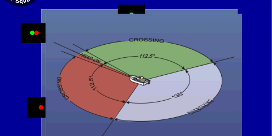There are key words in seamanship that are very useful but sometimes confusing. There is a fanciful legend that early boaters used a board to steer their vessels. Since most were right handed, the right side became known as the “Steer Board” side. Because the Steer Board Side would not be placed against a dock, the left side, or dock side of the vessel became known as the “Port Side”. As time went, on the expression “Steer Board” for right side evolved into “Starboard”.
Knowing these terms is valuable when discussing nautical right of way. When two boats approach one another, neither has the right of way! You may pass each other on either side although you should try to pass port to port. When boats approach each from any other point, several other rules must be considered. In this writing we will focus primarily on the actions to be taken by approaching vessels all under mechanical power.
The US Coast Guard’s COLREGS (Collision Regulations) provide us with a circle of explanation that clarifies the geometry of right of way that applies both day and night. The circle above displays the angles of right of way that apply both in day and night. During the day, the angles indicated must be apply even thought the lights may not be seen. At night, the placement and projection of navigation lights must serve to signal clearly those angles.
With the exception of Personal Watercraft and small paddle craft which have separate rules according to the state, all boats must display a red navigation light on the port (left) side of the bow. Between two approaching power boats, this signals that vessels approaching from your left side must “stop” or give way. Conversely, the display of the green navigation light on your starboard bow indicates that you are giving the go ahead to any vessel approaching on your right side and that you will stop or give way to them. Your white stern light tells to every vessel to your rear, that they must give way to you when trying to overtake you.
The red and green navigation lights must be visible from your bow tip to 112 ½ degrees aft on the respective side of the boat. Boats under mechanical power must display a white all around light. All vessels must also display the white stern light that must be seen in that 135 degree area in the back of the vessel not covered by the red and green. Some boats engaged in towing or fishing display very specific lights that they show. You should get to know them so you know how to avoid mishaps.
Contact us using the form below to learn about our next course offerings covering the Rules of the Road.
As USPS members continually remind us: “We are America’s Boating Club™”!
Submitted by P/D/C Pete TenBrink, Feature Writer, Marketing/Public relations Committee, United States Power Squadrons®
With permission of Boating Times, Long Island







